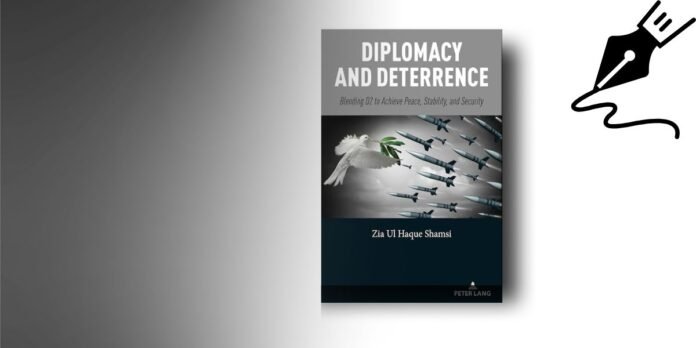As the world is going through a rapid transformation causing it to stand at a critical threshold by forcing nations to confront groundbreaking complexities. In this impulsive environment, the dire need of effective diplomacy in combination of credible deterrence has become more needed than ever. Dr. Zia Ul Haq Shamsi’s book, Diplomacy and Deterrence: Blending D2 to Achieve Peace, Stability, and Security, describes how these two concepts can be used side by side strategically to deal with these complexities. As I read through his book, it reminded me of the wisdom of Ali ibn Abi Talib from Nahjul Balagha—”be diplomatic in your dealings, and cautious in your movements”—Dr.Shamsi’s work reflects this combination of balancing dialogue with strength in governance.
Dr.Shamsi’s “D2” approach is driven through the balance between diplomacy and deterrence, opposing the typical mind set that contrasts soft power against hard power. Instead, he emphasizes on merging these two by illustrating Cuban Missile Crisis and the Iran Nuclear Deal to how peace and stability can be achieved through effective negotiation and credible containment. Given the example of Cuban missile crisis 1962, the author notes Kennedys approach to be a combination of diplomacy and deterrence where his public speeches and diplomatic efforts forced the Soviet Union to withdraw missiles.
On the other hand, the threat for military intervention and naval quarantine worked as deterrence sending them a clear message that there would be no space for tolerance of the presence of Soviet missiles in the Western Hemisphere.
Similarly, the example of the case of Iran’s nuclear deal, in which United States, the European Union and other world powers came to a landmark agreement with Iran limiting its nuclear program in exchange for relief from economic sanctions. Both these case studies emphasize Dr. Shamsi’s D2 concept as sustainable framework for policy makers to achieve peace and security simultaneously.
The author’s “D2” approach combines the strengths of both diplomatic efforts and a strong deterrent posture to foster trust and cooperation while preventing aggression. This concept is further illustrated through the example of the U.S.–China relationship, which serves as a compelling case for the D2 model. These two nations share a complex, multifaceted relationship: on one hand, they are deeply intertwined through economic and trade partnerships; on the other, they face significant strategic and security tensions that require careful deterrence and management. Implementing the D2 approach may involve diplomatic dialogues, trade and economic agreements, and security and military cooperation to build mutual trust and interests—alongside economic sanctions and military deployments as deterrent measures.
The author emphasizes that the D2 approach can be applied across a range of scenarios from preventing conflicts to mediating them—but it is far from simplistic. It demands a nuanced understanding of the complex interplay between diplomacy and deterrence. The significance of diplomacy in fostering peace, stability, and security is strongly underscored; the author argues that diplomacy is not merely a tool for conflict resolution but also a proactive means of preventing conflict altogether. Dr. Shamsi explains that effective diplomacy hinges on a deep appreciation of the cultural, historical, and political contexts of the actors involved, with an emphasis on building trust and credibility as the foundation for meaningful diplomatic engagement. At the same time, he acknowledges the critical role of deterrence in sustaining peace and security—not only as a response to aggression but also as a mechanism for preserving stability in uncertain environments. The author asserts that deterrence is most effective when underpinned by credible military capabilities and a clear, coherent communication of intent.
While the book provides a solid foundation, the evolving nature of global threats—ranging from cyber warfare and climate security to non-state actors, artificial intelligence, and other emerging challenges—could have been explored in greater depth. Nevertheless, it serves as a valuable starting point for future research, ensuring the continued relevance of the D2 approach in an increasingly complex world.
In conclusion, Diplomacy and Deterrence offers a meaningful contribution to the field of international relations, advocating for a thoughtful synthesis of dialogue and strength. This creative strategy resonates with Allama Iqbal’s vision in his essay Islam as a Moral and Political Idea, where he warns that knowledge without vitality breeds stagnation, while strength without wisdom devolves into recklessness. The D2 framework reflects Iqbal’s call for harmony between thought and action, fostering an environment in which diplomacy and deterrence reinforce—rather than undermine—each other. Ultimately, the book stands as both a guide and a cautionary reminder for policymakers and scholars: true security and lasting peace do not lie in choosing between diplomacy and deterrence, but in mastering their delicate balance—like a funambulist on a high wire, where every step demands precision, foresight, and unwavering equilibrium.
Syeda Shireen Wahid is a civil servant working as Inspector at National Highways and Motorway Police (NHMP)






